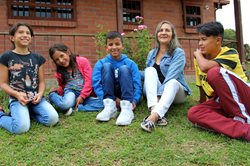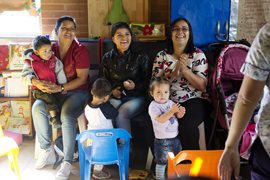A country rebuilding after decades of conflict
The Republic of Colombia, in the north-west of South America is home to roughly 48 million people, the country has the third largest Spanish-speaking population worldwide after Mexico and Spain.
For over fifty years, Colombia was marked by a complex and violent internal conflict. Over seven million people were displaced and an estimated 250,000 were killed. At the end of 2016, the peace agreement between the Colombian government and the Revolutionary Armed Forces of Colombia (Farc) marked an end to the fighting. This was seen as a first step to bring stability to the country.
In spite of the conflict, Colombia has seen significant economic growth in recent years; however, the income and wealth distribution remains highly unequal. Nearly 28 per cent of the population lives in poverty. Living conditions in rural and urban areas of the country differ significantly: in rural areas, over 35 per cent of the people lack access to clean water and proper sanitation. There is limited access to medical and educational services. In bigger cities, the situation is, in general terms, notably better. However some neighbourhoods in big cities, especially those where migrants first settle, are lacking basic public services.
Supporting refugees from neighbouring Venezuela
The political situation in Venezuela has resulted in many people seeking protection in Colombia. At the end of 2017, the Colombia Migration Office estimated that over 550,000 Venezuelans were living in the country. Additionally, there are thousands of people who cross the border daily to buy food, to work and receive health care – they then return to Venezuela at the end of the day.
Refugees live in a precarious legal situation, often in inadequate shelters, and struggle to find food and water. Children and young people – especially those who arrive on their own - are among the most vulnerable.
Children at risk due to violence and poverty
In spite of some recent improvements, Colombia's 18 million children are in need of further protection. The decades of armed conflict affected children and young people: many childhoods were marked by upheaval and insecurity.
According to some reports, one in three children lives in poverty. Approximately eight per cent of children are forced to work. The majority of them do not go to school.
Abuse and mistreatment of children is an issue that needs addressing: two children are killed and three are abandoned every day, according to the Institute of Legal Medicine.
SOS Children's Villages in Colombia
SOS Children’s Villages has been working in Colombia since 1971.
Strengthen Families: SOS Children's Villages works with local organisations and communities to support vulnerable families so that they can stay together. We ensure that they have access to basic goods and services such as health care and education. We also provide training and advice so that parents can break the cycle of poverty and generate an income to look after their children. Some of the families we support have arrived from neighbouring Venezuela.
Care in SOS families: If, in spite of all support, children are unable to stay with their parents, they can find a new home in an SOS family. Children grow up with their brothers and sisters in a safe environment. We also support young mothers and their children - they live together in an SOS family and are both cared for by the SOS mothers. Some families live integrated in the community. Wherever possible, we work closely with the children’s family of origin, so that the children can return to live with them.
Support for young people: We support young people until they are able to live independently. We give them access to further education and vocational training so that they have the right skills to find a job, or start their own business.
Emergency Response Programmes:
- Floods: In response to the floods that occurred in the south of Colombia in March 2017, SOS Children’s Villages provided support to affected children and families in Mocoa. We focused on helping unaccompanied children and vulnerable families.
- Refugees: In 2018 we plan to provide emergency care to refugee families and children. We aim to support vulnerable migrants, reunite children with their families, ensure that children are safe by, for example, creating Child Friendly Spaces where children can be cared for and regain some sense of normality.


